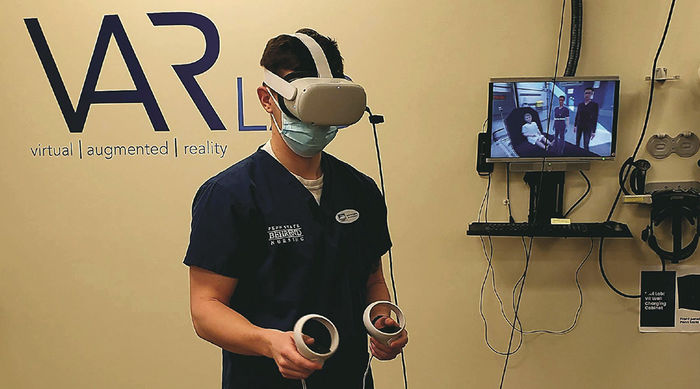Clinical rotations are invaluable to nursing students, giving them real-world experience in a guided environment. The model has limitations, however, particularly in acute care.
“Because of the acuity level of OB, ICU and ED patients, students don’t always have the opportunity to deliver direct patient care,” said Debra Loop, an assistant teaching professor of nursing and the simulation coordinator for the Nursing program at Penn State Behrend. “They quickly become passive learners as they take on the role of observer.”
Pediatrics brings another challenge for Behrend students: The sickest local children tend to be transferred to specialty hospitals in Pittsburgh or Cleveland. That limits the types of patients that students see during their rotations.
To create more opportunities for students, Loop and Heidi Rich, assistant teaching professor of nursing, introduced patient simulations using virtual reality (VR). They partnered with instructors at Penn State Fayette–both programs being part of Penn State’s Ross and Carol Nese College of Nursing–to offer VR interactions.
A $5,000 grant from the Schreyer Institute for Teaching Excellence paid for the software, but Loop didn’t have to look far for the other equipment, including the Oculus headsets used to create the immersive VR environments: Behrend’s Virtual/Augmented Reality (VAR) Lab works with programs in the college’s four academic schools to develop enhanced learning modules and training simulations.
“Immersive technologies have extensive interdisciplinary applications and proven benefits in academic outcomes,” said Dr. Christopher Shelton, assistant professor of clinical psychology and director of the VAR Lab. “This project is an effective way to leverage VR inside the classroom.”
Using the Oculus headsets and hand controls, the students worked through twenty-minute VR modules simulating the care of pediatric patients with asthma and diabetic ketoacidosis. They obtained a patient history, performed assessments, managed bedside tasks, and delegated work to a patient-care technician.
In each scenario, the student interacted with both the patient and the parents. That isn’t always possible in Behrend’s advanced nursing labs, which are equipped with high-fidelity simulation mannequins, including a pediatric model. In those labs, having a parent present means bringing in additional staff to enhance the simulation.
“We can’t always do that,” Loop said. “It’s important for students to be exposed to both, however. You need to be able to interact with the child and the parent, changing your vocabulary as you shift from one to the other, so everyone understands what’s happening.”
Traditional simulation is still fully integrated in the curriculum at Behrend, but Loop sees another advantage to using VR environments at times.
“In the traditional lab, only one person can be the primary caregiver in a simulation,” she said. “Everyone else sort of helps them out until they get a turn. In VR, you are always the primary nurse.
“In a group setting, you can always step back and let another student take over,” she said. “You can’t do that when you’re on your own. You have to make your own decisions, and you have to fully understand the reasons for those decisions.”
